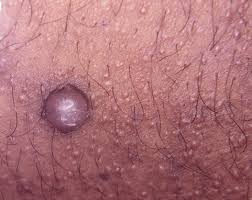Cutaneous tuberculosis (TB) is essentially an invasion of the skin by Mycobacterium tuberculosis, the same bacteria that cause TB of the lungs (pulmonary TB). Cutaneous TB is a relatively uncommon form of extrapulmonary TB (TB infection of other organs and tissues). Even in countries such as India and China where TB still commonly occurs, cutaneous outbreaks are rare (<0.1%).
Types of cutaneous TB
Several different types of cutaneous TB exist. Direct infection of the skin or mucous membranes from an outside source of mycobacteria results in an initial lesion called the tuberculous chancre. The chancres are firm shallow ulcers with a granular base. They appear about 2-4 weeks after mycobacteria enter through broken skin. The immune response of the patient and the virulence of the mycobacteria determine the type and severity of cutaneous TB.
| Types of cutaneous TB | Features |
|---|
| TB verrucosa cutis |
- Occurs after direct inoculation of TB into the skin in someone who has been previously infected with mycobacteria
- Presents as a purplish or brownish-red warty growth
- Lesions most often occur on the knees, elbows, hands, feet and buttocks
- Lesions may persist for years but can clear up even without treatment
|
| Lupus vulgaris |
- Persistent and progressive form of cutaneous TB
- Small sharply defined reddish-brown lesions with a gelatinous consistency (called apple-jelly nodules)
- Lesions persist for years, leading to disfigurement and sometimes skin cancer
|
| Scrofuloderma |
- Skin lesions result from direct extension of underlying TB infection of lymph nodes, bone or joints
- Often associated with TB of the lungs
- Firm, painless lesions that eventually ulcerate with a granular base
- May heal even without treatment but this takes years and leaves unsightly scars
|
| Miliary TB |
- Chronic TB infection that has spread from the primary infection (usually in the lungs) to other organs and tissues via the bloodstream
- Skin lesions are small (millet-sized) red spots that develop into ulcers and abscesses
- More likely in immunocompromised patients, e.g. HIV, AIDS, cancer
- The patient is generally sick
- Prognosis is poor (many patients die even if diagnosed and treated)
|
| Tuberculid |
- Generalised exanthem in patients with moderate or high degree of immunity to TB because of previous infection
- Usually in good health with no identifiable focus of active TB in skin or elsewhere
- Erythema induratum (Bazin disease) presents as recurring nodules or lumps on the back of the legs (mostly women) that may ulcerate and scar. It is a type of nodular vasculitis.
- Papulonecrotic tuberculid results in crops of recurrent crusted skin papules on knees, elbows, buttocks or lower trunk that heal with scarring after about 6 weeks.
- Lichen scrofulosorum is an extending eruption of small follicular papules in young persons with underlying TB.

|
Lupus vulgaris
 |
| apple jelly nodules |
 Scrofuloderma
Scrofuloderma -direct extension from underlying TB.
 |
| bluish red painless swelling, which breaks open to form sinuses |

Tuberculosis verucca cutis- inoculated from outside
 |
| indolent veruccous warty nodules with a seripinous edge |








No comments:
Post a Comment